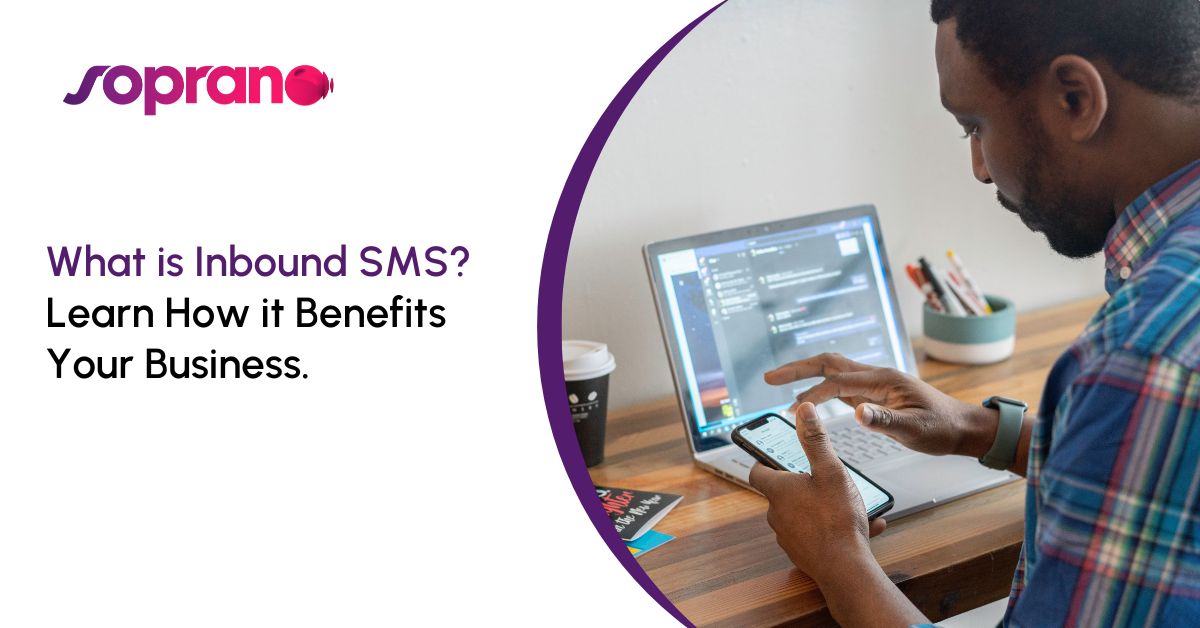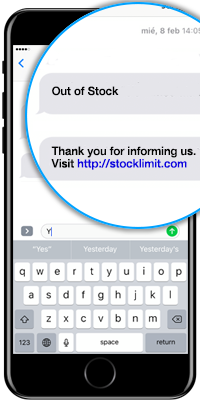*This article was last updated in June 2023.
Business SMS has become synonymous with outbound messaging, which involves sending messages, notifications, and reminders to staff and customers’ mobile devices. But did you know that you can also empower your recipients to initiate conversations with your business through inbound messaging? This article will explore what inbound SMS is and how integrating it can significantly benefit your business.
What is Inbound SMS?
Inbound SMS refers to users starting conversations with businesses using keywords, phrases, or shortcodes. It empowers individuals to send text messages directly from their mobile devices, initiating interactive and two-way SMS conversations with companies without relying on data or 3G networks.
Inbound messaging empowers stakeholders to send text messages directly from their mobile devices to engage and communicate with your internal business systems.
One of the most common forms of inbound messaging is text-in competitions. These competitions require participants to send a text message containing a specific keyword or shortcode to a designated number to enter.
Inbound SMS is closely related to A2P SMS, which involves the transmission of automated messages from applications or systems to individuals. A2P SMS encompasses many use cases, including transactional alerts, verification codes, appointment reminders, and promotional messages.
By utilising both as part of your mobile messaging strategy, you can create a seamless and interactive customer experience. Customers can initiate conversations with your business, while you can leverage A2P SMS to deliver automated responses, relevant information, and valuable updates.
This combination enables personalised and efficient communication, enhancing customer satisfaction, streamlined operations, and improved overall business performance.
The Importance of Inbound SMS for Businesses
Incorporating inbound SMS into your communication strategy has become imperative. The statistics speak for themselves, highlighting the significance of leveraging this dynamic channel to drive engagement, capture attention, and foster growth:
According to Statista, worldwide spending on SMS marketing currently stands at an astounding $327.1 billion, with the US emerging as the largest market. As businesses continue to recognise the value of SMS, this figure is projected to reach $339 billion by 2023, demonstrating the immense potential for businesses to tap into this lucrative market.
In line with these compelling numbers, recent studies have revealed that 41% of people strongly desire their favourite brands to send them updates via text, as reported by Thrive. This statistic reflects the growing demand for personalised, direct communication that SMS offers.
By leveraging inbound SMS, businesses can establish a direct line of communication with their audience, delivering timely updates, exclusive offers, and tailored messages that resonate with their customers’ preferences.
Moreover, LearnHub’s research emphasises that a remarkable 70% of consumers perceive SMS as an effective way for businesses to capture their attention. SMS stands out as a reliable and attention-grabbing channel in a world filled with constant digital noise. By implementing inbound SMS marketing campaigns, businesses can cut through the clutter, deliver concise and impactful messages, and establish a stronger connection with their target audience.
The speed of SMS engagement further reinforces its effectiveness. SimpleTexting reports that 1 in 3 consumers check their text notifications within one minute. This impressive statistic underscores the immediate and direct nature of SMS communication. By leveraging inbound SMS, businesses can ensure that their messages are promptly seen, increasing the likelihood of immediate action and response from their customers.
How Does Inbound SMS Work?
Inbound messaging can be activated through keywords or shortcodes. Let’s delve deeper into each to understand their functionality better.
1. Short Codes
Short Codes are five-digit numbers that serve as the gateway for customers to interact with your business. For example, sending a message to 70707 triggers an automated response from the system, acknowledging the user’s action, such as “Thanks for entering our competition.”
The primary advantage of shortcodes lies in their brevity. These easily memorable numbers allow users to recall them quickly when needed.
2. Keywords
Keywords play a crucial role in inbound messaging. Users can receive automated replies with relevant information by sending a message containing a specific keyword, such as “STOCK,” to a designated number.
For instance, they can get real-time updates on the inventory in stock.
When utilising keywords, it is essential to keep them concise and relevant to your business, ensuring that users can easily engage with your systems.
Implementing Inbound SMS: A Practical Example
Let’s consider a scenario where a mobile worker needs to report out-of-stock inventory using their mobile phone.
- User texts “OUT OF STOCK” to phone number.
- System automatically replies with an SMS including a URL pointing to an inventory management website.
- Forwards to employee email inboxes.
- Forwards to an internal group list set up to monitor inventory reports.
- Archives in server and logs.
Inbound Messaging Benefits
While mobile internet access is more prevalent than ever, SMS offers a distinct advantage by allowing users to send quick, spontaneous, and immediate messages from their mobile phones, even when 3G networks are unavailable.
Embracing inbound messaging provides a range of benefits for your business:
- Drive revenue and enhance productivity through inbound SMS campaigns that engage your audience.
- Streamline internal systems directly from your existing infrastructure by sending automated responses, such as stock inventory updates.
- Direct keywords to the appropriate departments or areas within your business, ensuring efficient handling of inquiries or requests.
- Seamlessly integrate SMS into your existing systems, optimising overall business operations and communication.
- Manage all inbound messaging from an enterprise SMS platform accessible from anywhere, providing convenience and control.
- Conduct multi-response campaigns using sophisticated inbound tactics to maximise audience engagement.
- Implement access control measures, such as blocklist and allowlist filtering, to ensure message security and compliance.
Getting Started with Inbound SMS
Inbound SMS offers a unique opportunity to engage with your customers on a more personal level, allowing them to initiate conversations and inquiries directly from their mobile devices.
Integrating inbound messaging into your business strategy can enhance customer satisfaction, streamline internal operations, and drive revenue growth.
When it comes to inbound messaging, utilising shortcodes and relevant keywords is crucial for effective communication. Shortcodes, those memorable 5-digit numbers, serve as the gateway for customers to interact with your business. They can easily send messages to these shortcodes, such as texting a keyword like “STOCK” to receive real-time inventory updates.
Incorporating these keywords ensures customers receive prompt and relevant SMS automation responses from your internal systems.
Inbound SMS campaigns powered by keyword-driven messaging have proven to be highly successful in driving revenue and improving productivity. Customers appreciate the seamless integration of SMS into your existing systems, allowing for easy access and engagement.
Whether it’s routing keywords to the appropriate departments or areas within your business or conducting multi-response campaigns, inbound messaging opens up a world of possibilities for sophisticated and targeted interactions
Moreover, the ability to manage all inbound messaging from an enterprise messaging platform ensures convenience and accessibility from anywhere. You can have complete control over the process, employing access control measures like blocklisting and allowing listing filtering to ensure the security of your messages.
Are you ready to explore the potential of inbound SMS for your business? Contact us today, and our dedicated team will guide you through implementing inbound messaging tailored to your needs.
Frequently Asked Questions:
- What are some specific examples of industries or businesses that have successfully implemented inbound SMS and seen significant benefits? Industries such as retail, hospitality, and event management have successfully implemented inbound SMS. For instance, retail businesses utilize inbound messaging for real-time inventory updates, while event management companies employ it to engage attendees through keyword-driven interactions during events.
- How do businesses typically manage and respond to a large volume of inbound messages, especially during peak periods, to ensure timely and personalized interactions? Businesses typically employ automated systems integrated with their enterprise messaging platforms to manage and respond to a large volume of inbound messages. During peak periods, these systems use predefined responses and routing mechanisms based on keywords, ensuring timely and efficient interactions. Human intervention is reserved for more complex inquiries.
- Are there any potential challenges or drawbacks associated with implementing inbound SMS, and how can businesses address or mitigate them effectively? One potential challenge in implementing inbound SMS is the need for careful keyword selection to ensure relevance and user engagement. Additionally, businesses may face increased demands on internal resources to handle the influx of messages. To address this, effective keyword planning and leveraging automated responses can mitigate challenges, ensuring a seamless and productive implementation of inbound SMS.



